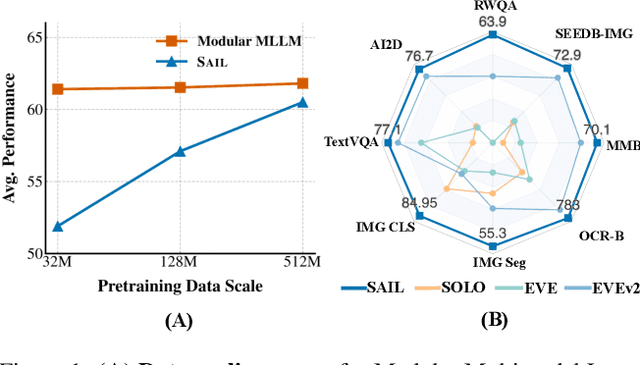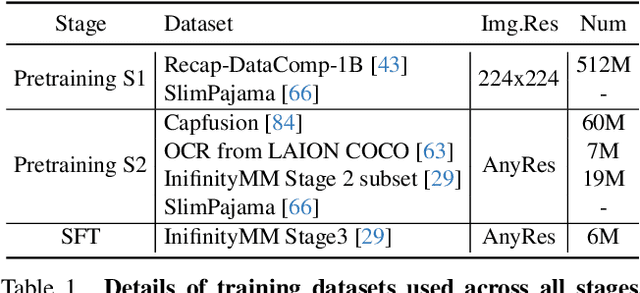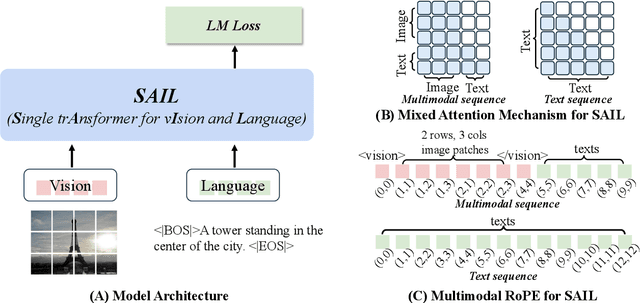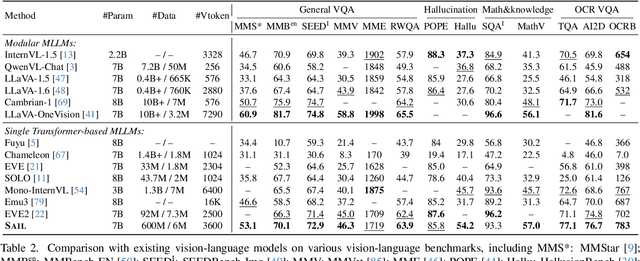Haochen Wang
Open-o3 Video: Grounded Video Reasoning with Explicit Spatio-Temporal Evidence
Oct 23, 2025Abstract:Most video reasoning models only generate textual reasoning traces without indicating when and where key evidence appears. Recent models such as OpenAI-o3 have sparked wide interest in evidence-centered reasoning for images, yet extending this ability to videos is more challenging, as it requires joint temporal tracking and spatial localization across dynamic scenes. We introduce Open-o3 Video, a non-agent framework that integrates explicit spatio-temporal evidence into video reasoning, and carefully collect training data and design training strategies to address the aforementioned challenges. The model highlights key timestamps, objects, and bounding boxes alongside its answers, allowing reasoning to be grounded in concrete visual observations. To enable this functionality, we first curate and build two high-quality datasets, STGR-CoT-30k for SFT and STGR-RL-36k for RL, with carefully constructed temporal and spatial annotations, since most existing datasets offer either temporal spans for videos or spatial boxes on images, lacking unified spatio-temporal supervision and reasoning traces. Then, we adopt a cold-start reinforcement learning strategy with multiple specially designed rewards that jointly encourage answer accuracy, temporal alignment, and spatial precision. On V-STAR benchmark, Open-o3 Video achieves state-of-the-art performance, raising mAM by 14.4% and mLGM by 24.2% on the Qwen2.5-VL baseline. Consistent improvements are also observed on a broad range of video understanding benchmarks, including VideoMME, WorldSense, VideoMMMU, and TVGBench. Beyond accuracy, the reasoning traces produced by Open-o3 Video also provide valuable signals for test-time scaling, enabling confidence-aware verification and improving answer reliability.
Grasp Any Region: Towards Precise, Contextual Pixel Understanding for Multimodal LLMs
Oct 22, 2025Abstract:While Multimodal Large Language Models (MLLMs) excel at holistic understanding, they struggle in capturing the dense world with complex scenes, requiring fine-grained analysis of intricate details and object inter-relationships. Region-level MLLMs have been a promising step. However, previous attempts are generally optimized to understand given regions in isolation, neglecting crucial global contexts. To address this, we introduce Grasp Any Region (GAR) for comprehen- sive region-level visual understanding. Empowered by an effective RoI-aligned feature replay technique, GAR supports (1) precise perception by leveraging necessary global contexts, and (2) modeling interactions between multiple prompts. Together, it then naturally achieves (3) advanced compositional reasoning to answer specific free-form questions about any region, shifting the paradigm from passive description to active dialogue. Moreover, we construct GAR-Bench, which not only provides a more accurate evaluation of single-region comprehension, but also, more importantly, measures interactions and complex reasoning across multiple regions. Extensive experiments have demonstrated that GAR-1B not only maintains the state-of-the-art captioning capabilities, e.g., outperforming DAM-3B +4.5 on DLC-Bench, but also excels at modeling relationships between multiple prompts with advanced comprehension capabilities, even surpassing InternVL3-78B on GAR-Bench-VQA. More importantly, our zero-shot GAR-8B even outperforms in-domain VideoRefer-7B on VideoRefer-BenchQ, indicating its strong capabilities can be easily transferred to videos.
DriveVLA-W0: World Models Amplify Data Scaling Law in Autonomous Driving
Oct 14, 2025



Abstract:Scaling Vision-Language-Action (VLA) models on large-scale data offers a promising path to achieving a more generalized driving intelligence. However, VLA models are limited by a ``supervision deficit'': the vast model capacity is supervised by sparse, low-dimensional actions, leaving much of their representational power underutilized. To remedy this, we propose \textbf{DriveVLA-W0}, a training paradigm that employs world modeling to predict future images. This task generates a dense, self-supervised signal that compels the model to learn the underlying dynamics of the driving environment. We showcase the paradigm's versatility by instantiating it for two dominant VLA archetypes: an autoregressive world model for VLAs that use discrete visual tokens, and a diffusion world model for those operating on continuous visual features. Building on the rich representations learned from world modeling, we introduce a lightweight action expert to address the inference latency for real-time deployment. Extensive experiments on the NAVSIM v1/v2 benchmark and a 680x larger in-house dataset demonstrate that DriveVLA-W0 significantly outperforms BEV and VLA baselines. Crucially, it amplifies the data scaling law, showing that performance gains accelerate as the training dataset size increases.
Traceable Evidence Enhanced Visual Grounded Reasoning: Evaluation and Methodology
Jul 10, 2025Abstract:Models like OpenAI-o3 pioneer visual grounded reasoning by dynamically referencing visual regions, just like human "thinking with images". However, no benchmark exists to evaluate these capabilities holistically. To bridge this gap, we propose TreeBench (Traceable Evidence Evaluation Benchmark), a diagnostic benchmark built on three principles: (1) focused visual perception of subtle targets in complex scenes, (2) traceable evidence via bounding box evaluation, and (3) second-order reasoning to test object interactions and spatial hierarchies beyond simple object localization. Prioritizing images with dense objects, we initially sample 1K high-quality images from SA-1B, and incorporate eight LMM experts to manually annotate questions, candidate options, and answers for each image. After three stages of quality control, TreeBench consists of 405 challenging visual question-answering pairs, even the most advanced models struggle with this benchmark, where none of them reach 60% accuracy, e.g., OpenAI-o3 scores only 54.87. Furthermore, we introduce TreeVGR (Traceable Evidence Enhanced Visual Grounded Reasoning), a training paradigm to supervise localization and reasoning jointly with reinforcement learning, enabling accurate localizations and explainable reasoning pathways. Initialized from Qwen2.5-VL-7B, it improves V* Bench (+16.8), MME-RealWorld (+12.6), and TreeBench (+13.4), proving traceability is key to advancing vision-grounded reasoning. The code is available at https://github.com/Haochen-Wang409/TreeVGR.
Holistic Tokenizer for Autoregressive Image Generation
Jul 03, 2025Abstract:The vanilla autoregressive image generation model generates visual tokens in a step-by-step fashion, which limits the ability to capture holistic relationships among token sequences. Moreover, most visual tokenizers map local image patches into latent tokens, leading to limited global information. To address this, we introduce \textit{Hita}, a novel image tokenizer for autoregressive (AR) image generation. It introduces a holistic-to-local tokenization scheme with learnable holistic queries and local patch tokens. Besides, Hita incorporates two key strategies for improved alignment with the AR generation process: 1) it arranges a sequential structure with holistic tokens at the beginning followed by patch-level tokens while using causal attention to maintain awareness of previous tokens; and 2) before feeding the de-quantized tokens into the decoder, Hita adopts a lightweight fusion module to control information flow to prioritize holistic tokens. Extensive experiments show that Hita accelerates the training speed of AR generators and outperforms those trained with vanilla tokenizers, achieving \textbf{2.59 FID} and \textbf{281.9 IS} on the ImageNet benchmark. A detailed analysis of the holistic representation highlights its ability to capture global image properties such as textures, materials, and shapes. Additionally, Hita also demonstrates effectiveness in zero-shot style transfer and image in-painting. The code is available at \href{https://github.com/CVMI-Lab/Hita}{https://github.com/CVMI-Lab/Hita}
VGR: Visual Grounded Reasoning
Jun 16, 2025Abstract:In the field of multimodal chain-of-thought (CoT) reasoning, existing approaches predominantly rely on reasoning on pure language space, which inherently suffers from language bias and is largely confined to math or science domains. This narrow focus limits their ability to handle complex visual reasoning tasks that demand comprehensive understanding of image details. To address these limitations, this paper introduces VGR, a novel reasoning multimodal large language model (MLLM) with enhanced fine-grained visual perception capabilities. Unlike traditional MLLMs that answer the question or reasoning solely on the language space, our VGR first detects relevant regions that may help to solve problems, and then provides precise answers based on replayed image regions. To achieve this, we conduct a large-scale SFT dataset called VGR -SFT that contains reasoning data with mixed vision grounding and language deduction. The inference pipeline of VGR allows the model to choose bounding boxes for visual reference and a replay stage is introduced to integrates the corresponding regions into the reasoning process, enhancing multimodel comprehension. Experiments on the LLaVA-NeXT-7B baseline show that VGR achieves superior performance on multi-modal benchmarks requiring comprehensive image detail understanding. Compared to the baseline, VGR uses only 30\% of the image token count while delivering scores of +4.1 on MMStar, +7.1 on AI2D, and a +12.9 improvement on ChartQA.
FastMap: Revisiting Dense and Scalable Structure from Motion
May 07, 2025Abstract:We propose FastMap, a new global structure from motion method focused on speed and simplicity. Previous methods like COLMAP and GLOMAP are able to estimate high-precision camera poses, but suffer from poor scalability when the number of matched keypoint pairs becomes large. We identify two key factors leading to this problem: poor parallelization and computationally expensive optimization steps. To overcome these issues, we design an SfM framework that relies entirely on GPU-friendly operations, making it easily parallelizable. Moreover, each optimization step runs in time linear to the number of image pairs, independent of keypoint pairs or 3D points. Through extensive experiments, we show that FastMap is one to two orders of magnitude faster than COLMAP and GLOMAP on large-scale scenes with comparable pose accuracy.
Integrating Learning-Based Manipulation and Physics-Based Locomotion for Whole-Body Badminton Robot Control
Apr 24, 2025Abstract:Learning-based methods, such as imitation learning (IL) and reinforcement learning (RL), can produce excel control policies over challenging agile robot tasks, such as sports robot. However, no existing work has harmonized learning-based policy with model-based methods to reduce training complexity and ensure the safety and stability for agile badminton robot control. In this paper, we introduce \ourmethod, a novel hybrid control system for agile badminton robots. Specifically, we propose a model-based strategy for chassis locomotion which provides a base for arm policy. We introduce a physics-informed ``IL+RL'' training framework for learning-based arm policy. In this train framework, a model-based strategy with privileged information is used to guide arm policy training during both IL and RL phases. In addition, we train the critic model during IL phase to alleviate the performance drop issue when transitioning from IL to RL. We present results on our self-engineered badminton robot, achieving 94.5% success rate against the serving machine and 90.7% success rate against human players. Our system can be easily generalized to other agile mobile manipulation tasks such as agile catching and table tennis. Our project website: https://dreamstarring.github.io/HAMLET/.
The Scalability of Simplicity: Empirical Analysis of Vision-Language Learning with a Single Transformer
Apr 14, 2025



Abstract:This paper introduces SAIL, a single transformer unified multimodal large language model (MLLM) that integrates raw pixel encoding and language decoding within a singular architecture. Unlike existing modular MLLMs, which rely on a pre-trained vision transformer (ViT), SAIL eliminates the need for a separate vision encoder, presenting a more minimalist architecture design. Instead of introducing novel architectural components, SAIL adapts mix-attention mechanisms and multimodal positional encodings to better align with the distinct characteristics of visual and textual modalities. We systematically compare SAIL's properties-including scalability, cross-modal information flow patterns, and visual representation capabilities-with those of modular MLLMs. By scaling both training data and model size, SAIL achieves performance comparable to modular MLLMs. Notably, the removal of pretrained ViT components enhances SAIL's scalability and results in significantly different cross-modal information flow patterns. Moreover, SAIL demonstrates strong visual representation capabilities, achieving results on par with ViT-22B in vision tasks such as semantic segmentation. Code and models are available at https://github.com/bytedance/SAIL.
Ross3D: Reconstructive Visual Instruction Tuning with 3D-Awareness
Apr 02, 2025Abstract:The rapid development of Large Multimodal Models (LMMs) for 2D images and videos has spurred efforts to adapt these models for interpreting 3D scenes. However, the absence of large-scale 3D vision-language datasets has posed a significant obstacle. To address this issue, typical approaches focus on injecting 3D awareness into 2D LMMs by designing 3D input-level scene representations. This work provides a new perspective. We introduce reconstructive visual instruction tuning with 3D-awareness (Ross3D), which integrates 3D-aware visual supervision into the training procedure. Specifically, it incorporates cross-view and global-view reconstruction. The former requires reconstructing masked views by aggregating overlapping information from other views. The latter aims to aggregate information from all available views to recover Bird's-Eye-View images, contributing to a comprehensive overview of the entire scene. Empirically, Ross3D achieves state-of-the-art performance across various 3D scene understanding benchmarks. More importantly, our semi-supervised experiments demonstrate significant potential in leveraging large amounts of unlabeled 3D vision-only data.
 Add to Chrome
Add to Chrome Add to Firefox
Add to Firefox Add to Edge
Add to Edge